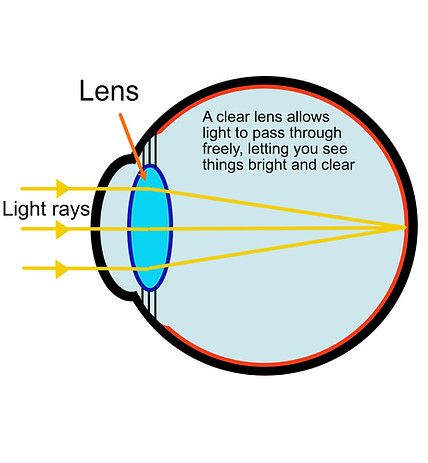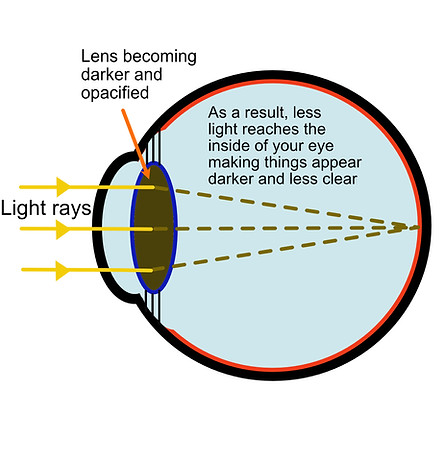Cataracts
What is a Cataract?
A cataract is a common eye condition that occurs when the lens of the eye becomes cloudy, leading to a decrease in vision. I sometimes describe this as windscreen or window pane that has become dirty/foggy – looking through this is difficult.


What causes Cataracts?
Getting wiser/aging: Cataracts are most commonly associated with aging and everyone who becomes wise enough eventually develops cataracts.
There are other less common causes such as trauma, medical conditions or genetics.
What are symptoms of cataracts? Do I have them?
-
Blurred or hazy vision
-
Difficulty seeing in low light
-
Sensitivity to glare, especially when driving at night
-
Fading or yellowing of colors
If you are concerned about cataracts, make an appointment to see an optometrist in your local area, or you could always get a referral to see me. We examine the eye with specialised equipment and will tell you if you have cataracts.
How are cataracts treated?
If your cataract is severe enough and/or affecting your vision, I would recommend cataract surgery. This is a surgical procedure to remove the cloudy lens and replace it with a new, clear artificial lens (made of materials such as acrylic).
What type of lens implants are there? What is the best implant? How do I choose the best intraocular lens?
Click here to download a summary PDF of lens choices
There is NO best or ultimate lens out there yet. The lenses, no matter how good they are, each have particular drawbacks – nothing can yet replicate the amazing natural lens in your twenties.
Because there are so many different brands and types of lenses, choosing the right lens can be a little bit overwhelming. I’ll try to summarise the main points below.
First, the “brands” or companies that are used in Australia are all reputable, well-established companies that have been making lenses for years. In terms of “quality”, they are all good and pretty similar i.e. it does not make much of a difference.
More importantly, you as the patient, together with your surgeon will need to decide what type of lens would best suit you and your lifestyle. This is key, because different lenses provide different types of vision.
Currently, there are 5 options to choose from
-
Monofocal for distance vision – by default, this is the most common choice, the most tried and trusted method since the advent of cataract surgery. Any patient would be suitable for this. The lens provides excellent distance vision in both eyes, and is also suitable for patients with other eye conditions such as diabetes or macular degeneration. The trade-off for this lens however, is that objects within 1 meter or less will be not in sharp focus. This will require reading glasses.
-
Monofocal for near vision – the aim of this choice is to provide clear near vision without the need for glasses. This is most suitable for patients who don’t drive and spend most of their time engaged in near activities such as reading, knitting or cooking. Glasses however, will be required for distance.
-
Mini-mono – This option is where one eye is set for good distance vision whilst the oder set for good intermediate vision. Good candidates for mini-monovision typically have: no history of eye problems, willingness to adapt to a new vision system.
-
Multifocal lens – these are newer lenses that provide reasonably good distance vision, midrange AND near vision with a slight compromise: less brightness, troublesome glare or halos around lights, and decreased sharpness of vision or contrast, especially at night or in dim light. These side effects can cause difficulty with driving at night.
-
Extended depth of focus (EDOF) – these are the latest lenses which provide good distance vision and good intermediate vision (for example the dashboard on your car). They have much less/or no side effects of haloes and glare that come with the multifocal lenses.
Type of lens | Most suitable for | Pros | Cons |
|---|---|---|---|
Monofocal for distance | Most patients - the most tested and tried lens choice.
Patients who desire excellent distance vision and are willing to wear glasses for near vision and intermediate distances. | Provides excellent distance vision. Proven technology with long-term results. | Requires glasses for near vision and intermediate distances. |
Monofocal for near | Patients who desire excellent near vision and are willing to wear glasses for distance vision.
Suitable for patients who spend most of their time engaged in near activities e.g. reading, knitting, cooking | Provides excellent near vision.
Proven technology with long-term results. | Will need prescription glasses for distance vision |
Mini-monovision | Patients wanting reduced dependence on glasses
(may still require for close work) | Good vision for distance and intermediate.
Reduced dependence on reading glasses | Reduced depth perception (as one eye is focused on far and the other for intermediate).
Adaptation period may be needed |
Multifocal | Patients wanting absolute glasses independence.
Not suitable for patients with other eye conditions e.g. macular degeneration | Good vision at all distances.
Glasses independence | May cause haloes and glare around lights.
May have decreased contrast |
Extended depth of focus | Patients wanting reduced dependence on glasses
(may still require for close work).
Less suitable for patients with other eye conditions e.g. macular degeneration | Good vision for distance and intermediate.
Reduced dependence on reading glasses | May still require glasses for close-up work.
May cause minor haloes or glare. |
It's just too confusing and hard to decide - what type of lens would you as the surgeon recommend?
Again, no one size fits all. But to summarise:
1. If your eye was healthy with only cataracts as the main problem, I would recommend an EDOF (extended depth of focus lens). This would give you good vision for distance and some intermediate vision (e.g. reading larger text on your phone). You STILL would need glasses for fine print however.
2. If your eye had other problems such as macular degeneration or severe glaucoma, the classic recommendation would be to go with a standard monofocal lens aiming for good distance vision. Glasses would be required for reading.
What can I expect from cataract surgery?
Cataract surgery is a very well-established procedure with very good outcomes. Surgery itself is usually 15 minutes or less and is done under local anaesthetic. An anaesthetist typically puts a drip in your arm and gives you some relaxing medication. You are laid down on your back, surgery is performed and before you know it the procedure is over! You get a nice cup of tea, a sandwich and it’s time to go home.
I usually see you in a day or two to ensure that everything is going smoothly. Most patients notice an improvement by day 1, however complete recovery usually takes about 3 weeks.
What is the aftercare AFTER surgery? When can I go back to work?
Your eye is covered with a pad and/or shield after surgery. This is removed on day 1, and your prescribed eye drops can be started. You will be reminded to keep the eye clean at all times to avoid the risk of getting an infection. The next appointment will typically be 3-4 weeks after. I usually advise patients to take at least 1 week off work and will provide a medical certificate for this. During this time, take it easy, avoid any straining or heavy lifting, keep the eye clean, read a good book or two, watch some Netflix and go out for nice leisurely walks.
Are there risks from cataract surgery?
Yes, as with any surgical procedure (or even daily activities such as driving), there is always a chance that complications can happen. Fortunately however, the risks of serious complications such as an infection inside the eyeball (endophthalmitis) are very low - the risk of this is approximately 1 in 2000 (0.05%). During our consult, I will discuss these risks in more detail, tailored to your eye and general health.
Please click here for a more in-depth discussion about surgical risks.